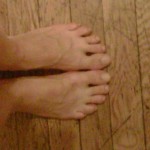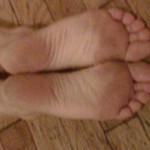
As summer comes slowly to a close, contributing writer Jessica Danser- Schwarz shares with her her disdain for toe nail polish and what has become a seemingly obligatory beauty ritual.
It never fails, every summer, to reach a peak of irritation, where I’m annoyed by it every day. It isn’t the heat, the humidity, or even the New York tourists. It’s toenail polish.
I was a typical female American teenager, slathering myself with a prodigious number of beauty products before deigning to be seen in public, but there were a few entities which continually pushed me in a different philosophical direction where beauty was concerned. One was my mother, who wears minimal makeup, and who set a LOT of boundaries about the age at which and the settings during which I was allowed to wear makeup. She was also very upfront about telling me that shellacking my face with cover-up would clog my pores and make my skin worse, wearing nail polish incessantly would make my nails weak and brittle, and that loads of hair gel was making my dandruff problem worse. She also refused to give me money to do things like get my nails done unless it was, like, the prom. (I’m pretty sure my mother has never had a professional manicure or pedicure, ever.) Although she had a few beauty vices of her own, such as dying her hair, the predominant message given to me at home was health first, and that natural beauty was best.
This is in sharp contrast to many of the young girls I teach now whose mothers seem to view beautification as an indoctrination best introduced early, girls who will argue with me fiercely when I tell them they have to remove their jewelry and put their hair up for dance class. I have had girls as young as 11 tell me they and their moms go together to get their legs waxed. One mother of a spirited 6 year old tomboy lamented an upsurge of “beauty parlor parties” for elementary-aged girls, where instead of pin-the-tail-on-the-donkey, the girls were “treated” to a full makeover: nail polish, full makeup, hair in curlers– not girlishy played with out of mom’s makeup, but administered by a professional beautician. “She hates this stuff,” said the mom, “but so many of the other mothers are throwing these parties I’m afraid she won’t have any friends if she doesn’t participate.”
The second influence was ballet. I had a strict, traditional Vagonova ballet teacher who had extremely clear limits on our appearance. Jewelry, fancy hairdos, and accessories were absolutely not tolerated under any circumstances in class, rehearsal, or performance. Stage makeup was to be identical to everyone else’s stage makeup and was not to include things such as bright blue eyeshadow or copious amounts of glitter. When my friends and I started to experiment with press-on nail extensions, those, too, were rapidly voted off the island. Her explanation: “It breaks your lines.” The message was very clear here, too: our beauty was to be found in our WORK, not merely our physical appearances. The gorgeousness of our dancing was in our movements, our precision, our performance and our spirit, not our fancy outfits, hairdos, or accoutrements.
Still and all I rocked the classic 90s- girl look from about age 12-16, to the extent I could get away with it, black eyeliner, dark lip liner framing light lip gloss, up-do piled on top of my head with a million hanging curly tendrils, doorknocker earrings, and I refused to go to school or any social event without all of it. I was afraid of ever letting a boy see my natural appearance, certain he would reject it. I actually remember wondering how I was going to manage to prevent my future husband from seeing me makeup-less when I grew up and lived with a mate. It was more than a little ridiculous. I was wearing a mask almost 24 hours a day, assuming that if people saw the way I actually looked it would be deemed inadequate (small wonder I felt this way, since all of the most “popular” girls were also the most precociously accessorized), and not even considering the possibility I might be liked for my intelligence and personality. The worst of it was that when I looked at my own naked face in the mirror, I no longer liked it.
A huge breakthrough happened one night when my new high school best friend came to spend the night at my house in the 9th grade. Right before we went to bed, after I had washed up to sleep, she caught a glimpse of my bare, makeupless face, wearing glasses, my hair pulled back in a simple ponytail. “Jessica… You’re BEAUTIFUL! Why on earth do you wear all that mess to school?”
My reaction to her comment wasn’t instantaneous, but it stuck in my head for a really long time. Gradually I started to tone down how much makeup I wore to school, and as I got more serious about ballet, the inconvenience of having to dismantle my banquet-worthy up-do every day for class started to wear thin. I realized that, as my mom had predicted, my skin was clearer and my hair was healthier when I wasn’t glomming goops all over myself every day. My cheap doorknocker earrings gave me an infection one time too many and I finally let my holes close.
I don’t recall exactly when, but one day around age 16 I made a decision: I would never, ever wear makeup ever again except for performance or photo shoots, and I would never paint my nails or re-pierce my ears ever for the rest of my life. I think a little eyeliner may have popped up for my senior prom, but beyond that I have, for over ten years, stuck to that resolution. I did not wear a stitch of makeup to my own wedding. And my husband was perfectly happy to say “I do” to the same natural face he would be looking at for the rest of his life.
It was an extreme and inflexible decision, to be sure, but ironically one of the things that kept my resolve was the amount of critique and incredulity I met from other women when I began on this new path. I try not to be judgmental of other women who chose to decorate themselves, but if I often feel that merely vocalizing my decision not to partake offends people and renders me some sort of weirdo or even, not a “real” woman. I have felt like that little 6 year old, shunned by her peers due to her aversion to “beauty parties,” so many times that my stalwart stance has become a bit defiant in nature.

I have gotten ONE pedicure my entire life, under duress before my cousin’s wedding when I was about 15. Even at that age I was cognizant that I had built up callouses from dancing which would have to be painfully developed again, and I begged the pedicurist, please, please, no pumice stone, don’t even touch the soles of my feet. She had no concept at all of what I was asking for or why and basically wrecked my feet. I felt angry and invaded. But there was something deeper than dance going on here, and it is that deeper outrage which starts to get under my skin after 2 summer months of seeing almost every single woman I encounter with elaborately decorated toenails. Why was it necessary for me to get my toenails painted in order to be a bridesmaid? Wasn’t my presence, my love for my cousin, my lovely dress good enough?


Feet are for walking, running, jumping, dancing, standing, climbing, balancing, kicking. They are a source of power. My relationship to my feet is very strong because of dance, and I love the look of my muscular, weathered, calloused feet. The natural look of my feet is a source of pride for me not only as a dancer, but as a woman. And seeing countless other women who doubtlessly use their bodies for amazing, productive things, reducing their feet to decorative objects bothers me, in the same way that advertisements which reduce women to decorative objects instead of people also bother me. Perhaps for some women the choice to decorate is a very personal and deliberate one, one which comes from a celebration of their beauty. But I imagine for many it is coming from an external societal pressure, based on relentless advertising educating us that airbrushed, heavily made-up, perfectly coiffed women are the ideal standard of beauty, and internal social pressures, such as those I feel when other women look at me like an alien when I mention I don’t like pedicures, or those I feel when I realize I am the only female on a subway car with sandals and unpainted toes. I am not condemning those who wish to decorate, but simply asking those who do to take a moment and ask themselves why? Are the decorations an extension of your own beauty, or a cover-up of things about yourself you find inadequate? When you spend time and money on beauty products, are you really “treating” yourself, or do you feel obligated to participate in these rituals?
Most people, especially in our society, have some sort of aesthetic routine around their appearance. But while a man may shave, comb his hair, and pick out a snazzy outfit, I know few men who spend even a fraction of the amount of time and money the average woman does on her physical appearance. When I see a woman with every inch of her being elaborately decorated, especially in a casual setting, I can’t help but wonder what other use her time, attention, and money could have been spent on besides her appearance. I know that when I changed my grooming habits as a young person it opened up not only more time, but more mental space for more productive, meaningful, and satisfying pursuits. It also changed my attitude towards myself from one of perpetual critique, disguising, and “fixing,” to one of greater acceptance and appreciation of all of my natural gifts, physical, intellectual, creative, and spiritual. Physical decoration is certainly not unique to our society. Indigenous cultures have a host of body decoration and modification rituals. It is an ancient human societal entity. However, what bothers me about it in our society is the extent to which it is a heavily advertised commercial field, urging us to pour loads of money and attention into our appearances; the fact that, unlike in many indigenous cultures, there is a HUGE inequality between the standards for men and those for women, rendering the women objects d’art whilst the men have few decorative requirements; and the fact that in a society which gives so much lip service to individuality, so much conformity around appearance is encouraged.
When I visited Trinidad last summer, I was refreshed and impressed to see that the majority of women in casual settings were dressed simply and comfortably and without any makeup or decoration. I did see women in more formal settings with a bit more accessorizing, but it was not over the top, nor was it the daily norm. The women I saw seemed relaxed and comfortable with their bodies, and far too involved with their tasks of farming, fishing, cooking, caring for their children, eating, swimming, dancing, and laughing to waste a lot of time staring in the mirror. And I felt way more comfortable around them than I ever do around American women. With these strangers from another culture, I felt an immediate sisterhood. No one was wearing a mask to shut me out.
It isn’t that I’m bothered that women wear toenail polish, I’m bothered when observation would lead me to conclude that ALL women in New York seem to now wear it every single day, as if it were a regimented requirement. And I’m bothered by how heavily the topic seems to come up in conversation and how much “getting a mani-pedi” seems to be a prime social activity among women friends. It makes me feel sometimes like I have abandon one of the beliefs I’m most proud of to fit in with other women. As silly as this may seem, toenail polish makes me feel lonely.
I would like to meet more women with rough, calloused hands and feet. Women whose bodies don’t hide the work they do. Women with ink-stained hands from writing poetry, dirty fingernails from planting vegetables, strong blistered feet from running and walking and dancing. These women, like my dear friend back from high school, might find me beautiful. But we would have so many other things to talk about it wouldn’t even matter.





















